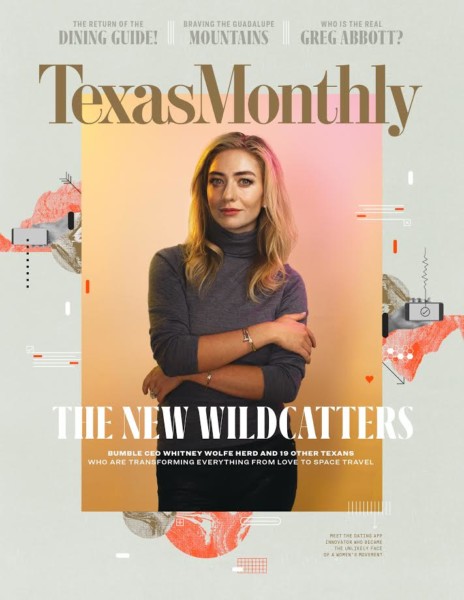Sign up for The Media Today, CJR’s daily newsletter.
It’s no secret that all media outlets–print and digital alike–are thirsty for pageviews and subscriptions. Lofty commitments to journalism and the truth aside, this is a business. And businesses require clicks.
But when the prowl for clicks becomes transactional, journalism runs into problems, as Tim Taliaferro, the editor-in-chief of Texas Monthly, is finding.
In an editorial meeting on January 17, staffers at the Austin-based magazine sat in “stunned silence” when Taliaferro, who arrived at the magazine last winter, seemed to suggest that the magazine had entered into a partnership with Bumble, the popular woman-centric dating app. The app’s founder, 28-year-old Texan Whitney Wolfe Herd, would be featured on the cover, and Bumble would use paid social media promotion to boost the story.
From archives: New editor in chief takes Texas Monthly in a ‘lifestyle’ direction
In an interview this week, Taliaferro denied such a deal existed, but emails obtained by CJR suggest that some sort of arrangement had been made, or that at the very least, Taliaferro was heavily involved in the social media strategy of a company featured in the pages of his own magazine.
Texas Monthly staffers reached out to CJR after the meeting, shaken by the nonchalant announcement of what they saw as a breach of journalistic ethics. “It was such a clear violation of one of journalism’s most fundamental ethical guidelines. And to hear him brazenly admit this deal in the meeting, bragging about it like it was some sort of major coup, it was like he truly didn’t understand why it was actually bad,” said one staff member, who asked not to be named for fear of retaliation. “To see this happen at Texas Monthly, which is known for its high standards, made me wonder where the line would eventually be drawn for this kind of thing. What other deals might be made with story subjects in the future and what other perks might Tim be willing to put on the table?” Another staff member did not believe that Bumble representatives had been shown the story, which hit newsstands on Wednesday, in advance or that they had any influence over the reporting process.
Taliaferro later told staff members that Bumble had agreed to spend between $25,000 and $30,000 on paid social media promotion of the story if Herd appeared on the cover.
The story on Herd and her app that ran in the magazine is glowing, and falls within Taliaferro’s stated goal to amp up the publication’s lifestyle coverage. (CJR reported on that shift in February 2017, prompting Taliaferro to complain on Twitter that his remarks had been taken out of context. CJR released a portion of the reporter’s notes, and Taliaferro later issued a letter to readers saying he’d given CJR “the wrong impression.”)
The Bumble feature sticks mostly to the origin story of the company and Herd’s profesional ventures, delving into her personal life only occasionally (to explain the legal fallout she had with Tinder, which she co-founded, and to gloss over her shift as a disbeliever in feminism to one of its chief marketers, for example). As the #MeToo movement ushered in a seismic shift in the way we talk about not just sexual harassment and assault, but dating and sex culture, too, Bumble’s focus on women makes the app uniquely newsworthy right now. The social network has over time expanded to include same-sex dating, people looking for business partners and a best friend match up, and in August, it turned down a buyout offer from Match Group for $450 million. Just days before the story in Texas Monthly ran, Bumble’s majority owner announced that it would seek a buyer, valuing the app at $1.5 billion.
CJR reached out to Taliaferro on January 23 requesting an interview about the story and the social-media push, which he quickly granted. But before that scheduled call, he addressed Texas Monthly staffers again, in an all-staff meeting on January 24. This time, staffers say he informed the newsroom that they’d misunderstood him. He insisted there had been no deal made with Bumble, that no promotion of the story had been promised by the representatives of the company or Herd prior to the decision to make it the cover story, and that no monetary amount to be spent on promotion had been promised.
In the interview with CJR, Taliaferro explained the reversal: “We made the decision to consider putting Whitney on the cover because she was the most recognizable and star of the [February Innovators] package. We were talking with her team and we told her what we were thinking. They said it meant a lot to Whitney and said they would promote the story,” said Taliaferro. “All this is once we made the decision. Our publicist and theirs worked together on how to roll it out. It’s not really different than what we do with most of our covers where we try to get attention on them.”
ICYMI: Analyzing Donald and Melania Trump’s relationship through photos
Staff members who spoke to CJR under the condition of anonymity confirmed that the Herd profile had long been discussed as a potential cover, making the decision to become involved in the promotional efforts confusing. One staffer said the courtship “cheapens” the staff’s efforts to keep the magazine’s integrity intact. But Taliaferro said no lines were crossed. “There was no formal agreement,” he added. “No money has changed hands.”
Yet language in emails obtained by CJR and sent from Taliaferro to representatives of Herd suggests there was some sort of more formal arrangement.
In an email sent on January 23 to associates of Bumble, Taliaferro appears to be heavily involved in their social media strategy, referring to a “plan” and emphasizing how high the stakes for the story are.
“I can’t stress enough how much is on the line for me with this deal,” he writes. “I must have this story perform and earn lots of eyeballs.”
In a different, undated email, a Bumble representative named Suzanne appears to refer to a prior arrangement and proposes that Bumble “invest in some paid social advertising.”
ICYMI: The story BuzzFeed, The New York Times and more didn’t want to publish
“We’ll commit to a $25K spend, as we know the web traffic is so important for [Texas Monthly] and is part of what we promised,” she writes. Taliaferro confirmed the legitimacy of these emails, dismissing them as little more than a “nitty gritty” conversation meant to help coordinate a social media push, and nothing more.
“This isn’t confusing at all. This is publicity within the normal types of conversations editors have with publicists. Bumble is not an advertiser. There is no agreement here. They haven’t paid us anything,” Taliaferro says, adding that had he not participated in these conversations, he’d be more worried. “Being in that conversation keeps those lines separate.” He added that the dollar amount was proposed by Bumble, and didn’t come up until days before the story went live. The decision to make Herd the cover, Taliaferro says, was solidified by early January and was likely to happen whether the company promoted it or not.

Whitney Wolfe Herd appears on the cover of Texas Monthly’s February 2018 issue. Courtesy photo.
Robbie McKay, who works on Bumble’s communications team, said that there had been no deal made with Texas Monthly exchanging paid social media promotion for the cover spot, and declined to confirm the dollar amount in the email. Bumble, he said, employs paid promotion for any major story about Herd or the app, and said that their interactions with Taliaferro were “more of a common conversation about co-promotion.” When asked if it’s typical for editors at publications running stories about Bumble to become intricately involved in their social media plans, McKay said he “wouldn’t call it uncommon,” and that the long period of time this particular story had been in the works contributed to an especially open line of communication between them.
ICYMI: “I spent 45 minutes on the phone with Megyn Kelly asking her to not run that show”
In a statement issued to CJR, Texas Monthly’s chairman and CEO Paul Hobby said that, “In the course of preparing this story on [Herd], we treated [her] the same way we do any of the cover subjects in the illustrious history of this magazine: smartly, fairly, and with the highest editorial standards.”
But members of the Texas Monthly staff say the confusion around the Bumble deal was given added weight by what for Taliaferro clearly are ambitious traffic goals that are guiding his decision-making. Taliaferro confirmed that digital growth, newsletters, “alternative social platforms,” and “more direct connections to the audience” are major priorities at the magazine this year.
Taliaferro is a former vice-president of communications for Texas Exes, the University of Texas’ alumni association and served as editor-in-chief of its magazine, Alcalde, where he focused heavily on digital and multimedia expansion–as all magazines have been forced to do. But while alumni magazines like Alcalde exist in a sphere that is adjacent to journalism, as arms of university communications and public relations departments, they don’t quite follow the same rules or subscribe to the same norms bound by more traditional journalism outlets like Texas Monthly.
It’s true that editors often make plans to push out stories on social media platforms–every publication now has a social media editor–and regularly interact with publicists. It’s the suggestion that it’s normal for editors to become this involved in a private company’s plan that is troubling. Paid social media promotion is, in some ways, an evolution of advertising–a gray space. The optics are risky, and in this case, they’re bad.
ICYMI: Former New York Times journalists are furious
Has America ever needed a media defender more than now? Help us by joining CJR today.



